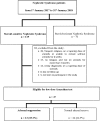Adrenal Insufficiency in Children With Nephrotic Syndrome on Corticosteroid Treatment
- PMID: 32351921
- PMCID: PMC7174641
- DOI: 10.3389/fped.2020.00164
Adrenal Insufficiency in Children With Nephrotic Syndrome on Corticosteroid Treatment
Abstract
Background: Adrenal insufficiency can result from impaired functions at all levels of hypothalamic-pituitary-adrenal (HPA) axis. We here studied risk factors associated with adrenal insufficiency in children receiving prolonged exogenous steroid treatment for nephrotic syndrome. Method:We performed low-dose Synacthen tests (LDSTs, 0.5 μg/m2) in children with steroid-sensitive nephrotic syndrome 4-6 weeks after discontinuation of the corticosteroid therapy. We measured early morning serum cortisol levels at baseline and at intervals of 10, 20, 30, and 60 min following the stimulation test. We defined normal HPA axis stimulation responses as those with peak cortisol cut-off values >550 nmol/L. Result:We enrolled 37 children for this study research. All children enrolled had normal early morning cortisol levels. However, 13 (35.1%) demonstrated HPA axis suppression (by LDST) 4-+6 weeks after discontinuation of oral prednisolone. Nephrotic syndrome diagnosed before 5 years of age (OR, 0.75; 95% CI, 0.57-0.99; p = 0.043), and steroid-dependence [OR, 5.58; 95% confidence interval (CI), 1.06-29.34; p = 0.042] were associated with increased risk of developing adrenal suppression after steroid discontinuation. Conclusion:HPA axis suppression, may go unnoticed without proper screening. A normal early morning cortisol level (275-555 nmol/L) does not exclude adrenal insufficiency in children with steroid-sensitive nephrotic syndrome. Further screening with LDSTs, particularly in children younger than 5 years at diagnosis, may be warranted.
Keywords: HPA axis; adrenal insufficiency; adrenal suppression; cortisol; low-dose Synacthen test; nephrotic syndrome; steroid withdrawal.
Copyright © 2020 Abu Bakar, Khalil, Lim, Yap, Appadurai, Sidhu, Lai, Anuar Zaini, Samingan and Jalaludin.
Figures
References
-
- Kidney Disease Improving Global Outcome Treatment of the Initial Episode of Steroid Sensitive Nephrotic Syndrome (KDIGO Guideline No. 3.1) (2012). Retrieved from: https://kdigo.org
-
- Tarshish P, Tobin JN, Bernstein J Edelmann CM. Prognostic significance of the early course of minimal change nephrotic syndrome: report of the International Study of Kidney Disease in Children. JASN. (1997) 8:769–76. - PubMed
-
- Webb NJA, Woolley RL, Lambe T, Frew E, Brettell EA, Barsoum EN, et al. . Long term tapering versus standard prednisolone treatment for first episode of childhood nephrotic syndrome : phase III randomised controlled trial and economic evaluation. BMJ. (2019) 365:l1800. 10.1136/bmj.l1800 - DOI - PMC - PubMed
LinkOut - more resources
Full Text Sources



